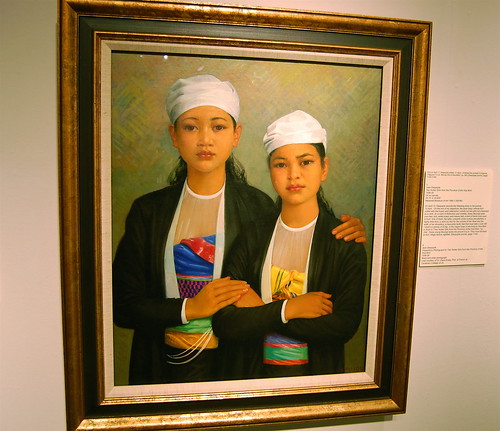Domino theory - Pres Eisenhower's fear that if communists were successful in taking over one Southeast Asian nation, that more nations would follow suit.
Gorilla in the living room - China.
US leaders knew that to provoke China into entering a conflict would be to unleash a giant foe. Yet no one wanted to discuss the China factor in a frank manner.
Vietnam War Timeline from Infoplease.com
U.S., South Vietnam, and Allies versus
North Vietnam (NVA) and National Liberation Front (Viet Cong).
1950
President Truman sends 35-man military advisory group to aid French fighting to maintain colonial power in Vietnam.
1954
After defeat of French at Dien Bien Phu, Geneva Agreements (July) provide for withdrawal of French and Vietminh to either side of demarcation zone (DMZ). Presidents Eisenhower and Kennedy (from 1954 onward) send US civilian advisers and, later, military personnel to train South Vietnamese.
1960
Communists form National Liberation Front in the South. These are hidden, guerilla types.
1960–1963
U.S. military advisers in South Vietnam rise from 900 to 15,000.
1964
North Vietnamese torpedo boats reportedly attack U.S. destroyers in Gulf of Tonkin (Aug. 2). President Johnson orders retaliatory air strikes. Congress approves Gulf of Tonkin resolution (Aug. 7) authorizing president to take “all necessary measures” to win in Vietnam, allowing for the war's expansion.
1965
U.S. planes begin combat missions over South Vietnam. In June, 23,000 American advisers committed to combat. By end of year over 184,000 U.S. troops are in the region.
1966
B-52s bomb DMZ, reportedly used by North Vietnam for entry into South.
1968
U.S. has almost 525,000 men in Vietnam.
In the Tet offensive (Jan.–Feb.), Viet Cong guerrillas attack Saigon, Hue, and some provincial capitals.
In My Lai massacre, American soldiers kill 300 Vietnamese villagers (March 16).
President Johnson orders halt to U.S. bombardment of North Vietnam (Oct. 31). Saigon and N.L.F. join U.S. and North Vietnam in Paris peace talks.
1969
President Nixon announces Vietnam peace offer (May 14)—begins troop withdrawals (June). Viet Cong forms Provisional Revolutionary Government.
U.S. Senate calls for curb on commitments (June 25). Ho Chi Minh, 79, North Vietnam president, dies (Sept. 3).
Massive demonstrations in U.S. protest or support war policies.
1970
U.S. troops invade Cambodia in order to destroy North Vietnamese sanctuaries (May 1).
1971
Congress bars use of combat troops, but not air power, in Laos and Cambodia (Jan. 1). South Vietnamese troops, with U.S. air cover, fail in Laos thrust. Many American ground forces withdrawn from Vietnam combat.
New York Times publishes Pentagon papers, classified material on expansion of war (June).
1972
Nixon responds to North Vietnamese drive across DMZ by ordering mining of North Vietnam ports and heavy bombing of Hanoi-Haiphong area (April 1). Nixon orders “Christmas bombing” of North to get North Vietnamese back to conference table (Dec.).
1973
President orders halt to offensive operations in North Vietnam (Jan. 15). Representatives of North and South Vietnam, U.S., and N.L.F. sign peace pacts in Paris, ending longest war in U.S. history (Jan. 27). Last American troops departed in their entirety (March 29).
1975
Full-scale warfare resumes. South Vietnam premier Nguyen Van Thieu resigns (April 21). South Vietnamese government surrenders to North Vietnam; U.S. Marine embassy guards and U.S. civilians and dependents evacuated (April 30).
More than 140,000 Vietnamese refugees leave by air and sea ("boat people"), many to settle in the U.S.
Communist govt in control.
skip to main |
skip to sidebar
For students and parents who love education and exploration of the social sciences . . .
Search This Blog
Followers
Blog Archive
-
▼
2011
(242)
-
▼
April
(27)
- The Odyssey of a Chinese teen: Not One Less
- Qin quiz number two
- Qin quiz / Magnet geography
- Caddo Magnet in Vans competition: please vote at v...
- Westminster Abbey, neighbor to the Houses of Parli...
- Westminster Abbey, London / map
- The skit of the First Emperor of China
- Asian festival a tribute to Filipino culture on sa...
- Dishes prepared for geography class: a special exp...
- Complete the sketch and coloring of your Chinese mask
- A life of conflict and achievement: the First Empe...
- Chinese mask and skit on the life of Qin Shihuangdi
- From Tibet to the East China Sea: the Middle Kingd...
- Lhasa: capital of the Chinese region of Tibet
- The ancient internet: Silk Road caravans connected...
- Quiz on all notes Chinese next class
- "Ni hao, wo jiao Robert!"
- Clubs vend lunch & dessert during the Spring picni...
- "Give me the money:" a profile of China in the mov...
- Xi'an: home of the first Emperor as well as movie ...
- China: the Middle Kingdom
- Open notes Magnet quiz about Vietnam in the next c...
- 'Nam: from China to the South China Sea
- Than Ti of the Buddhist Temple of Bossier
- Domino theory, Gorilla in the room: the Vietnam co...
- Angkor Wat, the grand Hindu-Buddhist temple of Cam...
- Magnet High benefit on Ap 15
-
▼
April
(27)

